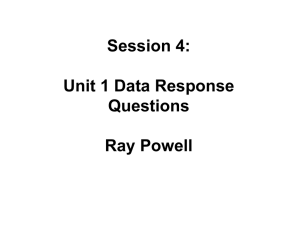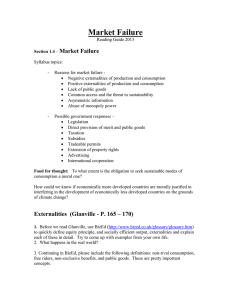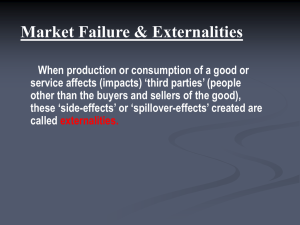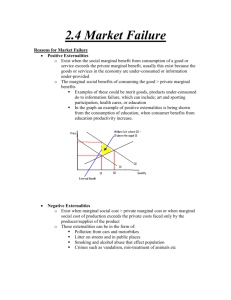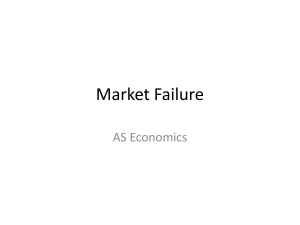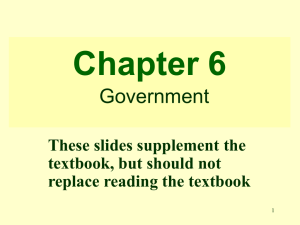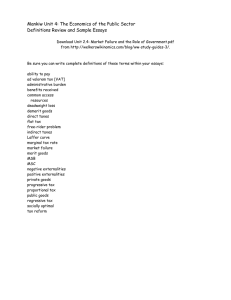CHAPTER 8: Dynamics of markets: Market failure
advertisement
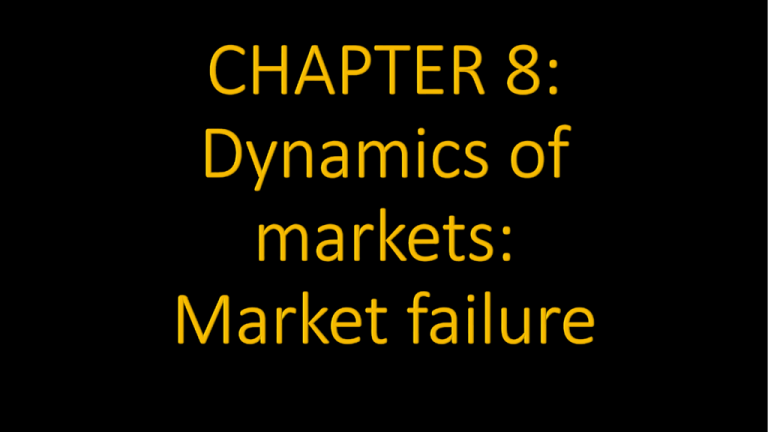
Explanation of the reasons for and consequences of market failures. Reflect on cost-benefit analysis. • The causes of market failures • Consequences of market failures • Cost-benefit analysis Market failure: when firms do not produce the quantity of output that would have been produced under the conditions of perfect competition. In LR under perfect competition… • Firms productively efficient & make normal profits. • Consumers pay lowest possible price • Produced at lowest average cost of production. • Society maximises output from scarce FOP’s • Changes in demand encourage firms to change industries allocatively efficient. Market failure occurs when the quantity of output produced is either too little or too great - allocative inefficiency. Quantity produced too little… • product under-produced & under-consumed • Society better off if more resources were used to produce the product. Quantity produced too great… • product is over-produced and over-consumed. • Society better off if less output produced & excess resources transferred to making other products in greater demand. The following are causes of market failure: 1. externalities 2. public goods 3. merit and demerit goods 4. imperfect competition 5. imperfect information 6. immobility of factors of production 7. unequal distribution of income and wealth 1.Externalities Externalities: costs/benefits of a transaction that affect economic agents who are not directly involved in the transaction or activity. When producing goods/services, private sector only take into account private costs and private benefits. Producers don’t take into account costs/benefits of production on society. These costs/benefits are called externalities. If externality results in a cost to society - negative externality. If externality results in a benefit to society - positive externality. AKA: third-party effects, side effects, spill-over effects or neighbourhood effects. Basic cost and benefit concepts : Private costs (internal costs): costs that the producer/consumer incurs voluntarily when they produce/purchase goods/services. Basic cost and benefit concepts : External costs (negative externalities): costs of production/ consumption decision that accrue to people other than the producer/consumer. Basic cost and benefit concepts : Social costs: total costs borne by society. Social costs = Private costs + External costs Basic cost and benefit concepts : Private benefits (internal benefits): accrue to consumers who purchase goods & producers that produce them. Basic cost and benefit concepts : External benefits (positive externalities): additional benefits to the community, caused by consumption or production of goods/services. Basic cost and benefit concepts : Social benefits: combined benefits to producers and society. Social benefits = Private benefits + External benefits The market for chemicals – negative externalities in production present Social costs Socially optimal equilibrium: social benefits = social costs Private costs External costs Free market equilibrium: private benefits = private costs Private benefit + external benefit = Social benefit The market for flu vaccinations – positive externalities in consumption present External benefits Private costs + External Costs = Social costs Socially optimal equilibrium: social benefits = social costs Social benefits Free market equilibrium: private benefits = private costs Private benefits Public goods: goods provided by the government, which exhibit characteristics of non-excludability and non-rivalry in consumption. Non-excludability: even if the good is produced for the use of one consumer, no other consumer can be prevented from consuming it. Non-rivalry: if one person consumes the good, it does not prevent someone else from also consuming the good. Problem - no-one else will pay as they will be able to consume the above goods free of charge – FREE RIDERS Public goods are under produced by market system -too few consumers prepared to pay Under allocation of resources to production of public goods - market fails. Merit goods: goods that society feels should be consumed by its citizens because it increases the welfare of the individual person and of society as a whole. Merit goods under-produced and under-consumed in free market people underestimate value. Demerit goods: goods that may be harmful to society as a whole (creates negative externalities). Social costs Private costs Social benefit Over-produced and over-consumed In summary… • under-allocation of resources to production of merit goods • over-allocation of resources to production of demerit goods Monopoly, oligopoly and monopolistically competitive firms restrict supply to maximise their profits. Therefore resources under-allocated Productively inefficient - output not produced at lowest AC Perfect competition - consumers & producers have perfect information to make informed production/consumption decisions. Real world of imperfect competition = asymmetric/imperfect information. https://www.youtube.com/watch?v=cYcsFyim_Cs Principal–agent problem: principal has more information than the agent), may use this information to benefit from the transaction. Under these conditions… • Demerit goods over-produced and over-consumed • Merit goods under-produced and under-consumed Perfect competition – FOP assumed perfectly flexible. Real world FOP NOT perfectly mobile… • Capital usually fixed • Governments impose controls on movement of labour between countries. • Within countries, labour sometimes inflexible. • SA: shortage of 500 000 skilled workers; surplus of 4 million unskilled workers. Economy’s capacity to produce less than under conditions of perfect competition - allocative inefficiency, or market failure. How do consumers indicate their preferences to producers??? Bearing this in mind, when income/wealth unevenly distributed… • Too many resources used to produce output for rich • Too few resources used to produce output for poor. Now complete… Activity 1 – page 188 Activity 2 – page 193
